What common birds in Florida can you find and recognize? There sure are many types of birds, from waterbirds, birds of prey, to songbirds, and even avians that are only visiting for the summer or winter.
Out of the many birds that live in Florida, we have made a list of the ones frequently spotted in the region. Shall we get to know them more?
Table of Contents
Bird Species in Florida
Florida has a flourishing wildlife. The Florida Ornithological Society Records Committee (FOSRC) stated that there are over 500 avian species, including the most common birds and rarer species, including the American black duck and dark-eyed Junco in northwest Florida.
The birds native to Florida range from backyard birds to not-so-common species that only appear during a certain period. To satisfy your curiosity about them, read on!
1. Sandhill Crane
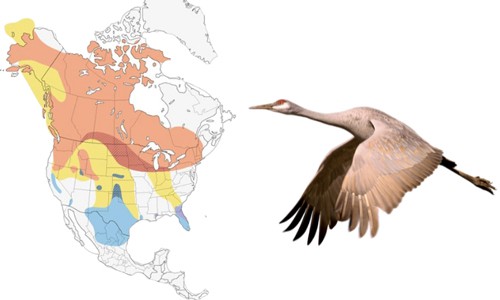
- Scientific Name: Antigone canadensis
- Weight Range: 3,400 to 4,900 grams
- Approximate Length: 120 centimeters
- Wingspan: 200 centimeters
Sandhill Cranes are large birds with long necks and legs. They have slate gray plumage, rust-red tinted upper parts, pale cheeks, and red foreheads. Both sexes have the same color pattern, while juveniles lack the red crown and white cheeks.
These water birds frequent fields, prairies, wetlands, tundras, grasslands, and marshes in North America. They are omnivores and feed on aquatic plant roots, insects, berries, seeds, and rodents.
In the winter, these cranes move to the south. They have nesting grounds in Siberia and sometimes cross the Bering Strait to arrive at their destination. Young birds follow their parents during migration.
2. House Sparrow
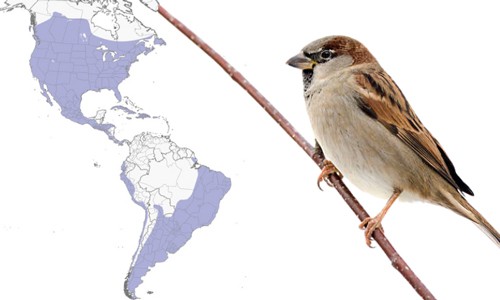
- Scientific Name: Passer domesticus
- Weight Range: 27 to 30 grams
- Approximate Length: 15 to 17 centimeters
- Wingspan: 19 to 25 centimeters
These brown birds are often confused for other North American Sparrows, but you can distinguish the former with their full chests, bulky bodies, round heads, and short tails.
Male House Sparrows are mainly brown with black stripes, pale cheeks, and gray crowns. Females differ from males with their duller plumage, pale brown stomachs, and smaller size.
House Sparrows are social birds, always found close to people and communities across North America and around the world. They inhabit places near houses, parks, and farms. Find them perched on trees and roofs, waiting for discarded foods and livestock feeds.
The majority of these birds’ population usually stay in their regions throughout the year, except for some subspecies which are predominantly migratory.
3. Red-eyed Vireo
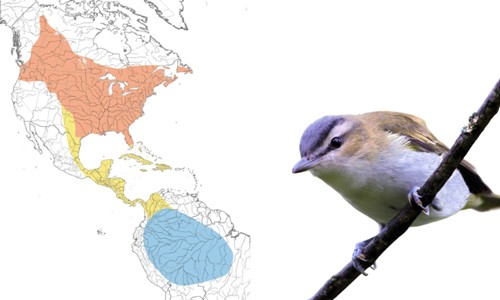
- Scientific Name: Vireo olivaceus
- Weight Range: 12 to 26 grams
- Approximate Length: 12 to 13 centimeters
- Wingspan: 23 to 25 centimeters
This small songbird has a chunky body, angled head, thick neck, and long beak with a hooked tip. You can recognize this bird with its white belly, olive-green upperparts, and distinct pattern that consists of a black-bordered white stripe above the eyes.
Red-eyed Vireos are migratory birds that inhabit deciduous forests. They come to Florida in mid-July and are found on maple trees and woods with wide-leaf trees. Their diets include caterpillars, aphids, and other insects found on tree foliage.
The plumage of these birds enables them to camouflage among the green leaves. This is effective in hunting their prey but ironically, their unceasing singing draws attention.
4. Bald Eagle
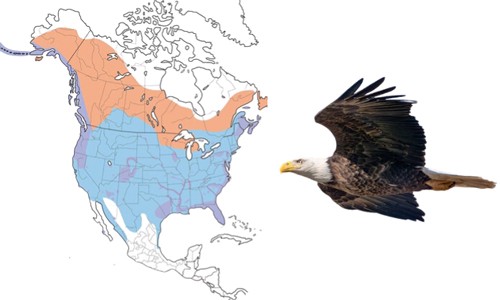
- Scientific Name: Haliaeetus leucocephalus
- Weight Range: 3,000 to 6,300 grams
- Approximate Length: 71 to 96 centimeters
- Wingspan: 204 centimeters
Bald Eagles are known as the emblem of the United States. Their wedged tail, yellow beak and eyes make them recognizable. Juveniles are dark brown with white molting, and females are generally bigger than males.
Find these birds in North Florida, where they are permanent residents all year. You can spot them around coastal areas, lakes, and rivers around South Florida. They fly high in the sky and often rest on branches or the ground.
These birds of prey feed mainly on fish, snatching them from the water with strong and sharp talons. They also hunt for waterfowl, gulls, and mammals. Most of their meals involve tormenting other scavenger birds eating garbage and carrion.
5. Cedar Waxwing
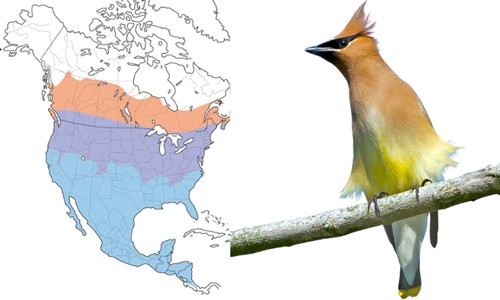
- Scientific Name: Bombycilla cedrorum
- Weight Range: 32 grams
- Approximate Length: 14 to 17 centimeters
- Wingspan: 22 to 30 centimeters
These medium-sized birds are named after their wax-like wingtips with a tint of red. It is hard to miss their light yellow bellies, black eye mask, gray tail with vivid yellow tips, and breasts that transition into gray towards the wings.
Immatures have a somber color compared to adults with their smaller eye mask and rougher breast streaks.
Cedar Waxwings are native to the woodlands, suburban gardens, and orchards of Central and North America. You’ll find them in a different location each year, which is no surprise given their nomadic nature. They are one of the many migrant birds that visit Florida.
During the mating season, Cedar Waxwing feeds more on insects. But their diet also consists of sweet fruits and berries. Spot them in flocks sitting on fruit tree branches or flying over the water for food.
6. Eastern Bluebird
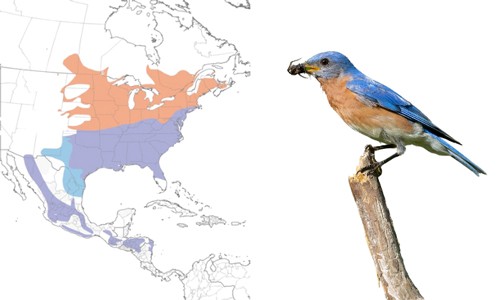
- Scientific Name: Sialia sialis
- Weight Range: 28 to 32 grams
- Approximate Length: 16 to 21 centimeters
- Wingspan: 25 to 32 centimeters
Eastern Bluebirds are one of the most widespread bluebird species. Males have the iconic blue color for their upper parts and reddish chest and throat. Females differ slightly with their light blue tails and wings, gray upper parts, and soft orange-brown chest.
Despite the “eastern” in their name, these birds’ range reaches south to Nicaragua. They are everywhere in the meadows and nest boxes around North America, and you can observe these small birds in Florida around open areas and field edges.
These bluebirds feed on invertebrates and wild fruits. They hang out on branches and fence posts, waiting to catch their prey.
7. Northern Mockingbird
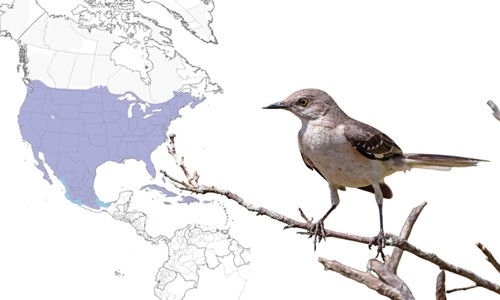
- Scientific Name: Mimus polyglottos
- Weight Range: 45 to 58 grams
- Approximate Length: 21 to 26 centimeters
- Wingspan: 31 to 35 centimeters
Northern Mockingbirds are identified by their gray feathers and long tails. Their wings have white bars and patches that look more visible when they are in the air. Immature birds are distinguishable with their gray-green irises and spots on their chest.
These Central Florida birds frequent backyards, towns, suburbs, and open lands. They are native to the north but escape to the south when the weather becomes unfavorable. Their diet consists of arthropods, seeds, fruits, and small crustaceans.
It is hard not to notice these birds with their bold personalities and impressive mimicking ability. They love to sing a lot and mimic all types of sounds, from barking dogs to car alarms.
8. Song Sparrow
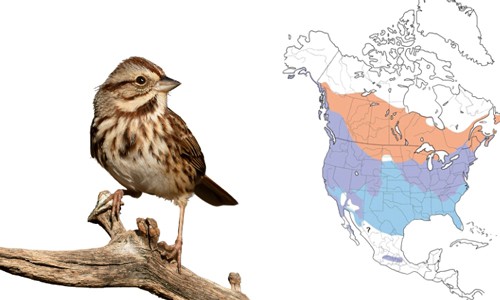
- Scientific Name: Melospiza melodia
- Weight Range: 12 to 53 grams
- Approximate Length: 12 to 17 centimeters
- Wingspan: 18 to 24 centimeters
There are many similar-looking sparrow species in the wild, making it tricky to identify them, except for the Song Sparrow. These songbirds’ identifying features include brown chest streaks, gray cheeks and eyebrows, reddish brown crowns, and red-gray bodies.
Song Sparrows are birds of Florida. They frequent marshes, brushlands, desert washes, backyards, and forest edges across Canada and the United States. During winter, you’ll find them in the south and Mexico.
These sparrows nest in grasses and weeds, sometimes directly on the ground. They also prefer to forage on land and in shrubs and shallow water, looking for small crustaceans to eat.
9. Carolina Wren
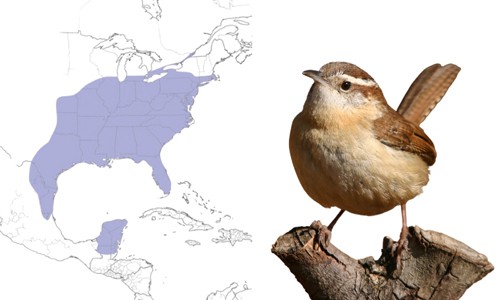
- Scientific Name: Thryothorus ludovicianus
- Weight Range: 18 to 22 grams
- Approximate Length: 12 to 14 centimeters
- Wingspan: 29 centimeters
These tiny birds are large for a wren, the second largest wren in the United States. They are also the most colorful with their vivid red-brown upper parts, warm rust-orange under parts, dark beaks, and very short neck. Both sexes share the same features.
Carolina Wrens are common in farm edges, suburban areas, forests, and backyards in northeast Mexico, south Ontario, Canada, and East of the United States. Their northern range varies each year and sometimes moves south to avoid the harsh winter.
It is common to find these birds on the ground hopping jerkily in search of bugs and seeds. Carolina Wrens live in pairs and sing duets all season.
10. Swallow-tailed Kite
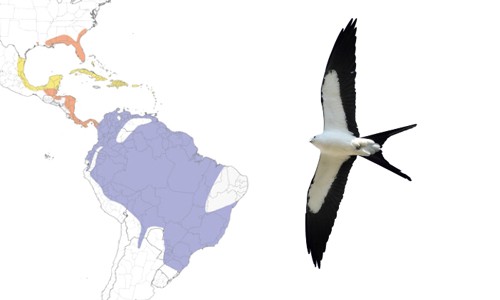
- Scientific Name: Elanoides forficatus
- Weight Range: 370 to 600 grams
- Approximate Length: 50 to 54 centimeters
- Wingspan: 122 centimeters
Swallow-tailed Kite is a pernine raptor with a black and white color pattern. Both males and females have deep black wings, feet, beaks, and elongated forked tails. Their white heads, wing linings, and underparts are a stark contrast to their black feathers. Juveniles have paler plumage color and shorter tails.
These raptors are easily spotted in marshes, swamps, and large rivers across the southeastern part of the United States, specifically in Florida. Their breeding range extends to north Argentina and east of Peru. In the spring, they migrate to nesting areas to start breeding.
It is rare to find these birds breaking flight during feeding. Their diet depends heavily on small amphibians and large insects. In Central America, some of them are found to consume fruits regularly.
11. Palm Warbler
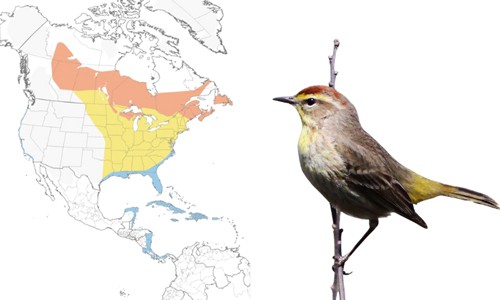
- Scientific Name: Setophaga palmarum
- Weight Range: 7 to 13 grams
- Approximate Length: 12 to 14 centimeters
- Wingspan: 20 to 21 centimeters
This small songbird is considered large for a warbler. It has brownish-olive feathers with yellow throats and undertails. During mating season, their scarlet cap is on full display, but outside of the breeding season, you’ll recognize them with their dark eye line and pale eyebrows.
Palm Warblers can be found in open coniferous bogs and boreal forests in the northeastern United States and Canada. These thicket birds frequent low-lying vegetation or grounds and can be easily spotted with their incessantly bobbing tails.
During winter in Florida, Palm Warblers stick around palm groves foraging the ground for food or flying to catch insects. They’re often spottable from September onwards.
12. Spotted Sandpiper
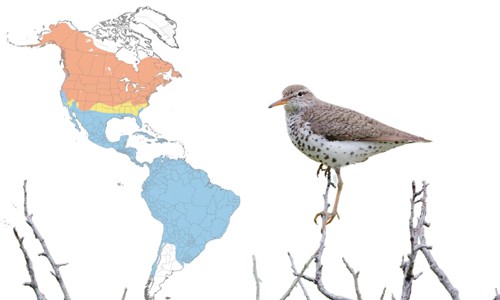
- Scientific Name: Actitis macularius
- Weight Range: 34 to 50 grams
- Approximate Length: 18 to 20 centimeters
- Wingspan: 37 to 40 centimeters
Spotted Sandpipers are medium-sized shorebirds with a beak that is a tad shorter than their head. Their spotted white breast, orange beak, and dark brown back are bolder in the breeding season. During winter, the spottings will all disappear, leaving them with a slightly plain look.
This shorebird is widespread all over the United States and Canada. They prefer areas close to the water but are mostly solitary. These birds tend to reuse their breeding sites, and males handle the incubation process.
The distinct teeter and constantly bobbing tail are some of the unique behaviors of Spotted Sandpipers. They have several foraging techniques used to hunt their prey; they can crouch low and stalk slowly but are also quick to dash or fly and grab their targets.
13. Tufted Titmouse
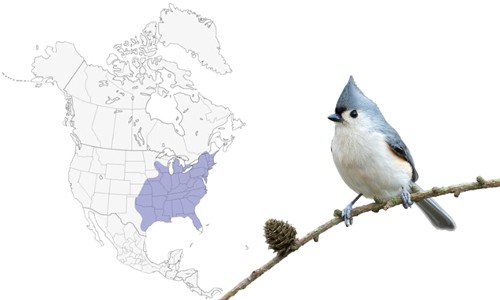
- Scientific Name: Baeolophus bicolor
- Weight Range: 18 to 26 grams
- Approximate Length: 14 to 16 centimeters
- Wingspan: 20 to 26 centimeters
The Tufted Titmouse’s large head and eye, bulky body, and thick neck make it stand out among all the small birds in the feeders. Other features to distinguish these birds are their white under parts, gray upper parts, black patch above the bills, and stout bills.
These small birds are native to the Mississippi River Basins. They live in groves, woodlands, forests with tall trees, and sometimes in city parks, suburbs, and orchards. Their range continues to expand in the north.
Tufted Titmouse forage for food on the ground and sometimes by hanging upside down on tree branches. They tend to pick up food from feeders and eat it elsewhere.
Conclusion
The list we have is only some of the common birds in Florida. There are still more out there. Can you name a few birds found in Florida that are not included in this article?
Have you encountered any of them? Were you able to recognize them after a few minutes? We want to hear your story. Share them with us in the comment section!
Most Common Birds in:

George and I became friends after a birdwatching trip with our new group. And we have been enjoying every adventure together. When he told me the idea of establishing a site that shares our experiences and fun, I immediately agreed. After trials and errors, here we have Thayerbirding.














